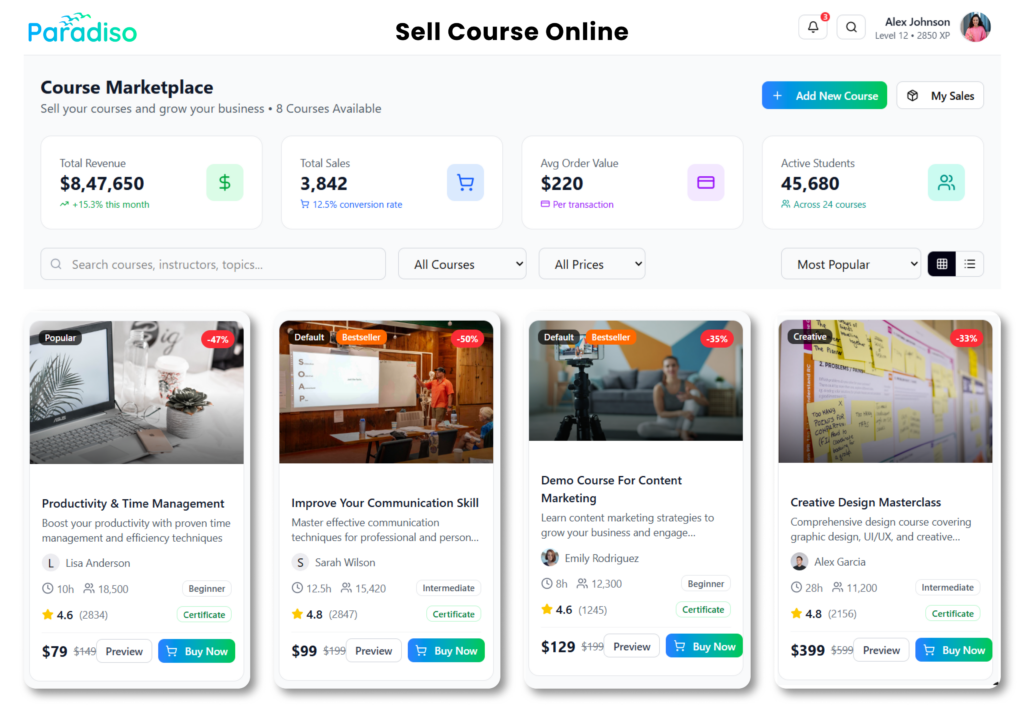Online course developers like you need to stay current on the newest digital marketing trends as the online education market expands if they want to make their courses stand out from the crowd.
What should we expect in terms of digital marketing developments in 2023? And how can you apply them to your online course and business?
In today’s article, we’ll take a look at some 2023 key marketing trends in the online course creation and digital marketing landscape, so you can stay up-to-date and deliver the best online course for your students.
Personalization and Targeting
Personalization is at the top of our list of upcoming digital marketing trends for authors of online courses in 2023.
In 2023, a one-size-fits-all digital marketing strategy won’t be sufficient to draw in students because today’s consumers demand a highly personalized experience. This is particularly true for online courses, where personalization and one-on-one support can significantly improve the learning experience for students.
A good way to personalize your students’ experience before they become your customers is to segment your audience and use different messaging for different customers
Video Marketing
A compelling approach to present your course is through video, which is a potent marketing tool for online courses. Due to the interactive aspect of this format, we anticipate seeing a rise in the use of video marketing in the online course industry in 2023.
One way to use video in your digital marketing efforts is through sharing free informational content or creating previews of your next course launch, which offer potential students a sneak peek at what your course has to offer.
Influencer Marketing
Influencer marketing is a form of marketing in which brands partner with individuals who have a significant following on social media or other online platforms. These individuals, known as influencers, promote the brand’s products or services to their followers, leveraging their personal brand and credibility to reach new audiences and drive conversions. Here are some key elements of influencer marketing:
- Brand-influencer partnership: Brands collaborate with influencers to promote their products or services to the influencer’s followers.
- Influencer selection: Brands carefully select influencers who are a good fit for their products or services and who have a significant following in their target market.
- Authenticity: Influencer marketing is based on the idea of authenticity, which means that influencers are chosen because they are seen as credible and relatable by their followers.
- Measurable results: The results of an influencer marketing campaign can be measured by looking at metrics such as engagement rates, website traffic, and sales.
- Micro-influencers: Micro-influencers are individuals with a smaller following, but with a high level of engagement from their followers.
- Long-term collaboration: Brands often choose to collaborate with influencers on a long-term basis, building a relationship with the influencer and their audience.
Gamification
Gamification is the process of incorporating elements of game design into non-game contexts, such as marketing, in order to increase engagement and motivation. Here are some ways that gamification is being used in digital marketing:
1.Interactive content: Interactive content such as quizzes, polls, and games can be used to engage audiences and drive conversions.
2.Loyalty programs: Gamification can be used to create loyalty programs that reward customers for engaging with a brand.
3.Branded games: Brands can create branded games that are designed to promote their products or services.
4.Virtual and Augmented Reality: Gamification can be used to create engaging experiences in virtual and augmented reality that promote products or services.
5.Gamified advertising: Gamified advertising is a new form of advertising that incorporates game elements to make ads more engaging and interactive.
6.Contests and giveaways: Gamification can be used to create contests and giveaways that incentivize customers to engage with a brand.
Smart Speakers: A New Channel for Digital Marketing
Smart speakers, such as Amazon’s Echo and Google Home, are becoming increasingly popular and are providing a new channel for digital marketing. Smart speakers allow users to interact with digital devices using natural language, and they are becoming a common way for people to access information, play music, and control other connected devices. This presents a new opportunity for businesses to reach consumers in new ways.
- Voice search optimization: As more people use voice assistants to search for information, it will become increasingly important for businesses to optimize their content for voice search.
- Voice commands: Smart speakers allow users to control other connected devices through voice commands. This presents an opportunity for businesses to create “skills” or “actions” that allow users to interact with their products or services through voice commands.
- Audio Advertising: Smart speakers allow businesses to reach consumers through audio ads. As users listen to music or other audio content on their smart speaker, businesses can insert short audio advertisements.
- Smart Home Integration: Smart speakers are often the hub of the smart home and connecting to them allows brands to control other devices in the home and personalize the experience for the user.
- Personalized experience: Smart speakers can be used to create a more personalized experience for the user by using data on customer behavior to make personalized recommendations and provide customized information.
Chatbots in Marketing
Chatbots are computer programs that are designed to simulate conversation with human users. They are being increasingly used in marketing as a way to interact with customers in real-time, answer questions and provide personalized recommendations. Here are some ways chatbots are being used in marketing:
- Customer service: Chatbots can be used to automate customer service tasks, such as answering frequently asked questions, providing product or service information, and helping customers navigate a website.
- Lead generation: Chatbots can be used to engage with website visitors and collect contact information for follow-up marketing.
- Personalized recommendations: Chatbots can analyze customer data and make personalized recommendations for products or services that the customer is likely to be interested in.
- E-commerce: Chatbots can be integrated with e-commerce platforms to assist customers with their purchase decisions and help them complete transactions.
- Marketing automation: Chatbots can be used to automate marketing tasks, such as sending personalized follow-up messages or triggering targeted marketing campaigns based on customer behavior.
- Cost-effective: Chatbots are relatively inexpensive to develop and maintain, and they can be used to handle a high volume of customer interactions.
- 24/7 Availability: Chatbots can be operational 24/7 and can assist customers regardless of their location or time zone.













